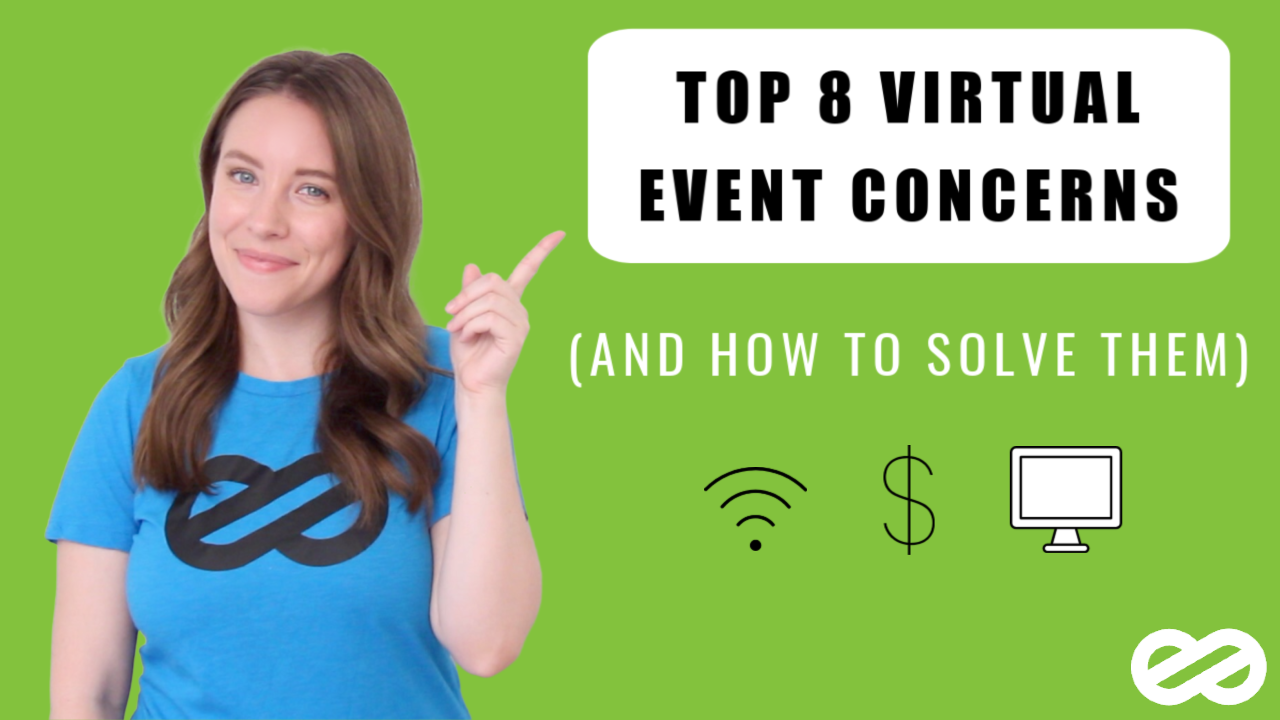Preparations for your event might be in full swing, but there are still virtual event concerns you must address! Here at Endless, we’ve been on a quest. A quest to help you dive into the world of virtual events as seamlessly as possible. And during this journey, we’ve already covered some relevant topics. For instance, we gave you an overview of how to convert an in-person experience into a virtual one. And recently, we addressed the most common mistakes made in this scope.
But today, we’re diving a little deeper. Because when putting together a virtual event, many things can fly over your head. Which is normal! Most of this is probably brand new for you. So in order to keep pursuing our goal of helping you out in this transition, we’re looking at the top virtual event concerns you should address. Keep reading to find out what things you should be paying close attention to, and how to solve them. All in the name of a successful virtual event experience!

Attendees’ Bandwidth Ability
Needless to say, the Internet plays a fundamental part when it comes to virtual events. While with a typical in-person experience, the lack of good, fast WiFi is more of an annoyance than a full-blown problem, things shift in the new paradigm. Because everyone involved in the experience – you, the attendees, the speakers, the entertainment – will be attending the event remotely. And obviously, this is all possible thanks to technology and a quality Internet connection.
But while it’s easier for planners to have control over their own connection and train the speakers in the same sense, it’s not quite as easy on the attendee side. How can you be sure the audience will have the necessary speed and quality of WiFi? Have they even considered this is something to keep in mind in order to make the most out of the experience? While this will depend on the tech-savviness of your audience, the answer is probably not.
So, how can you solve this? Communicate! Chances are, you prepared a good marketing strategy for your virtual event that includes steps to take pre-event. It’s during this time that you should issue instructions and warnings aimed at your attendees. Let them know what the ideal bandwidth is. Ask them to make sure no one else around the house will be using it to its full capacity during the event. And make sure you emphasize that, the better the connection, the better their experience will be!
Cybersecurity Concerns
When planning an in-person event, security is always something planners are mindful of. Entire teams are employed in order to ensure everyone is safe during big gatherings because there are several risks on the horizon. And while virtual events don’t pose a physical threat to attendees, there are still security concerns attached – more specifically, cybersecurity concerns.
But it’s not like this is the first time planners had to face this particular enemy. As an industry, we are guardians of a ton of valuable information through our registration systems and our apps. And we haven’t exactly been careful about this either. Think back to when you arrived at an event to get registered and the password to have access to the whole system was written in a post-it and stuck to the laptop. So while we’ve always been vulnerable to hackers, we mostly failed to acknowledge the risk was there at all.
However, with the new state of things, disregarding cybersecurity is a no-go. The information and personal data of your attendees is in your hands. The event itself is in your hands too. And the best thing you can do is, first, know that this is something to address. And secondly, reach out to your virtual event production company and ask them how you can keep everyone safe. They will know the right steps to take, or who to call in order to provide you with the virtual version of a security team.
Webinar Fatigue
We can’t talk about virtual event concerns without discussing webinar fatigue. And this probably isn’t news to you, right? Audience engagement and fatigue were probably two of the biggest reasons why virtual events didn’t become more popular in the past. But since the events industry doesn’t have any other choice right now, we must address this.
It goes without saying that human beings have a short attention span, something that’s only gotten worse as history progressed. Getting people to pay close attention to five, seven, or ten-hour long webinars isn’t a reasonable expectation. And especially not when they’re at home, surrounded by distractions like Netlix, their little kids, their gaming systems, and so on. So, how can you go about solving this issue?
Firstly, re-consider the format of your virtual event. Instead of doing fewer days and more hours per day, instead, go for more days with fewer hours every day. That’s the first step you can take to combat webinar fatigue. And the second is investing as much as you can in audience engagement strategies. Head out to our article about the subject for an in-depth guide!
Activating Exhibitors And Sponsors
Sponsors will continue to be a big part of events, even as they shift to virtual. While it might seem like a bit of a struggle considering the uncertainty surrounding the world in general, planners have to remember that the digital sphere offers a lot of opportunities that sponsors will want to take advantage of. It’s up to planners to brainstorm and come up with ideas on how to activate exhibitors and sponsors during a virtual event.
But the number one way to go about it is through data. Information is the new currency, and analytics tools represent a goldmine in the world of sponsorships. If you harness the power of data in order to know your audience as best you can, then you can pick and choose the best and most relevant sponsors to be a part of the experience. Chances are, these sponsors are offering something that speaks to the audience, thus increasing the chances that the sponsors themselves will get leads and potential customers.
How To Price Your Virtual Event
It’s understandable that many planners and companies have no idea how to price their virtual events. Right now, we’re witnessing a complete shift in paradigm, which can be scary, yes. But it’s also an opportunity to define ourselves as game-changers and be the ones who set the rules. It’s very much trial and error, but if there’s one thing you shouldn’t even consider is making your event free out of fear that people won’t want to attend.
Remember that you have value, and people will be willing to pay and give you their time if you’re offering something unique, something useful that can improve their lives. There are several strategies you can follow in terms of pricing. If you want to dive deeper into how to solve this particular concern, check out our in-depth article on the subject.
How To Deal With Music Licensing
Virtual event concerns come from all sides. Sometimes, sides you didn’t even know existed in the first place. One of these concerns is related to music. You can’t expect to be able to play Ella Fitzgerald’s greatest hits free of charge at your event – and this applies to pretty much every song people are familiar with.
Your best option here is to go with royalty-free music. There are several platforms that offer this service, so choice won’t be a problem. We personally recommend Soundstripe, a company that offers royalty-free music for creators. You can even get access to three free tracks from any playlist in order to test the waters!
Humanizing The Experience
The events industry is, and always will be, inherently human. This industry was built on the foundation of human connection, bringing people together, creating unforgettable experiences that will last for a lifetime in the memories of the attendees. And of course, this is easier to achieve through an in-person experience. Many planners out there are resistant to the idea of virtual events because they simply don’t believe they can live up to the traditional experience.
But this is where things are headed. And you can either be a part of the change and make it better for everyone involved or simply remain a nay-sayer that refuses to see that the world and the way people connect evolve. We’re not saying in-person events will be replaced forever – they won’t. But virtual events offer many amazing opportunities that the traditional ones don’t. More sustainability, more inclusion, different experiences.
And humanizing these experiences is the first step in making everyone involved warm-up to virtual events. Invest in good design, engage with your audience, don’t make it overwhelming. Pour your heart and soul into connecting with the people who are attending from everywhere in the world, and provide them with the right tools to engage with each other. Because if you do, there’s no way they won’t come back for more.
Presenters Being Poor Engagers
On the topic of humanizing the experience, we arrive at the last of our virtual event concerns. Your speakers will be the ones commanding the room. They’ll be the ones charged with keeping the audience happy and engaged through their words, their content, and their actions towards the people who are attending. But what happens if your presenters are poor engagers?
As harsh as it sounds, this is a point in your planning where you simply can’t settle. Our advice is that you go for speakers who have previous experience with virtual events and virtual presentations. If they’ve done this before, chances are, they know exactly how to shake the room, include everyone, and juggle all the things that a virtual event demands. But if you can’t have access to someone who’s “been there, done that”, then you have to make sure the people you do hire are willing to undergo the necessary training. Whatever it takes, they have to do it. Because a poor engager can very easily become the downfall of the entire experience.












